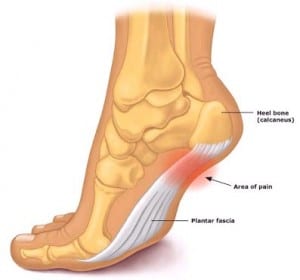Plantar Fasciitis is a condition caused by inflamation and/or damage to the plantar fascia tissue that connects your heel bone to your toes, and creates the arch in your foot.
As time goes by and if corrective measures aren’t adopted, the condition can get worse, and the pain increases.
Here is a short list of symptoms that can help you determine if your Plantar Fasciitis condition is getting worse.
- You feel pain longer through the day
- The level of pain is increasing
- The pain has moved to other areas of the foot
- You now have pain in your back, hips, knees or ankles
We will now look in more depth at each of these tell tale signs of plantar fasciitis getting worse.
You feel the pain longer through the day
Plantar Fasciitis is at its worst in the morning when you first try to get out of bed.
During the night as you sleep, the plantar fascia has contracted and partially healed itself. As you awake in the morning and stand to take your first steps, the partially healed plantar fascia can begin to tear open again as your body weight is added to your foot. This is what gives you that initial morning pain.
After a few steps, those minute tears have once again opened as much as they intend to (for now) and the pain begins to subside and go away.
Over time those minute tears will begin to get bigger. As they get bigger, the initial pain you feel in the morning will start lasting longer and this is a sure sign that your plantar fasciitis is getting worse.
Related Article: Why Does Plantar Fasciitis Hurt More In The Morning?
The pain level is increasing
When you first develop Plantar Fasciitis, you may not even realise you have the problem. It usually starts of as a mild discomfort in the heel of your foot. The discomfort may increase slightly and you may feel as though you have a small pebble in your shoe. That discomfort will turn to mild pain and then continue to get worse until you find you are in agony each time you add weight to your foot.
As mentioned in the previous point, the minute tears in your plantar fascia begin to get bigger and bigger over time. If you have not taken action to try and eliminate your plantar fasciitis through rest and gentle stretching, the problem will continue to worsten until you end up with the possibility of a major tear or even a plantar fascia rupture.
If you allow your plantar fascia to go unchecked to the point of a major tear or rupture, you can expect some disruption to your daily life as these conditions are much more severe and take much longer to recover from. Usually a period of total rest and then walking boots are required to allow your foot to heal.

Related Article: Is It A Tear, Rupture or Heel Spur?
The pain has moved to other areas of the foot
The most common place to plantar fasciitis pain is in the heel of the foot. Sometimes the pain can also be felt in the ball of the foot.
The plantar fascia runs along the base of the foot from your heel bone to your toes. It is the anchor points of the heel and toes where initial pain most commonly begins.
If you have pain in either the heel or ball of the foot, and then that pain spreads to other parts of the foot, this is another sign that your plantar fasciitis may be getting worse.
As the plantar fascia becomes damaged with those minute tears we talked about earlier, it is weakend and cannot properly perform its function of supporting your weight. This lack of support could see you develop an over pronation of the foot, also known as becoming ‘flat footed’.
Once this happens, your plantar fascia will be stretched to its maximum almost all the time which will further weaken it and allow further damage to occur. As this damage spreads along the plantar fascia, you will begin to feel pain along the sole of the foot and possible along the sides of the foot.
You now have pain in your knees, back or hips
As the pain in your foot increases and lasts longer into the day, you will start to adjust your gait as you walk to try to walk with a limp to relieve the pressure on your painful foot.
This change in your gait can start to apply extra pressure on your knees, hips and lower back as these areas are put under unnatural strain to compensate for your unbalanced posture.
Over time you will find that you now have pain in these areas too. This is a sure sign that your Plantar Fasciitis has getting worse, and that you may unconsciously be creating more health problems for yourself.

Conclusion
Plantar Fasciitis can be a very painful and debilitating condition if allowed to worsen over time. Usually the pain in the beginning is more of a minor discomfort than actual pain and this is the time that you should begin taking action.
If you feel pain in your heel or base of your foot each morning when you first stand up or apply weight to your foot, you may be developing Plantar Fasciitis.
NOW is the time to take action!!!
If you put off addressing the problem, the pain will only increase over time and your recovery will be so much longer.
Take a look at our other articles related to this topic:
